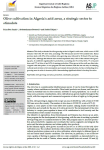Ben Sayah F., Boutouil A., Tidjani S. (2025). Olive cultivation in Algeria's arid areas, a strategic sector to stimulate. Journal algérien des régions arides, 01/07/2025, vol. 18, n. 2, p. 16-21.
https://asjp.cerist.dz/en/article/272439
https://asjp.cerist.dz/en/article/272439
| Titre : | Olive cultivation in Algeria's arid areas, a strategic sector to stimulate (2025) |
| Auteurs : | F. Ben Sayah ; A. Boutouil ; S. Tidjani |
| Type de document : | Article |
| Dans : | Journal algérien des régions arides (vol. 18, n. 2, July 2025) |
| Article en page(s) : | p. 16-21 |
| Langues : | Anglais |
| Langues du résumé : | Anglais |
| Catégories : |
Catégories principales 06 - AGRICULTURE. FORÊTS. PÊCHES ; 6.4 - Production Agricole. Système de ProductionThésaurus IAMM OLEICULTURE ; ZONE ARIDE ; DEVELOPPEMENT AGRICOLE ; ALGERIE |
| Résumé : | This study evaluates the olive-growing sector in Algeria’s arid areas, which covers 16 500 hec-tares with 4 501 397 olive trees, including 3 963 844 massed and 537 553 isolated trees. Biskra province leads with 30% of the southern olive-growing area, followed by El Oued (21%) and Laghouat (15%). Although the Saharan olive orchard represents only 3.66% of the national olive-growing area, it contributes significantly to production, accounting for 6% of total trees, 7% of massed trees, and 37% of olive oil and 63% of canning production. Olive groves in the south are often intercropped with date palms. A vast program has been launched with the aim not on-ly of satisfying national needs in terms of oil consumption and canned olive production, but also of extending olive-growing areas in order to increase yields, demonstrating significant efforts to develop the sector. |
| Cote : | En ligne |
| URL / DOI : | https://asjp.cerist.dz/en/article/272439 |







